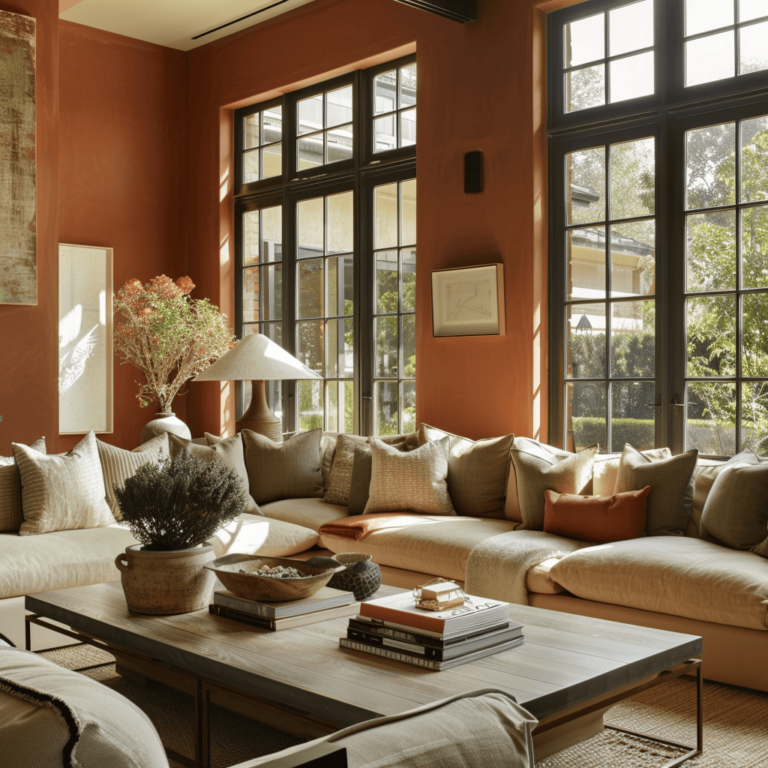
Step into the serene world of minimalist Japanese living rooms, where simplicity reigns supreme and every element serves a purpose.
These spaces are not just about aesthetics; they embody a lifestyle that values tranquility and understated elegance.
From the soft glow of natural light filtering through shoji screens to the comforting textures of tatami mats, each room tells a story of peace and simplicity.
Let’s explore a collection of 18 stunning ideas that will inspire you to embrace this beautiful style in your own home.
1. Open Spaces with Natural Light
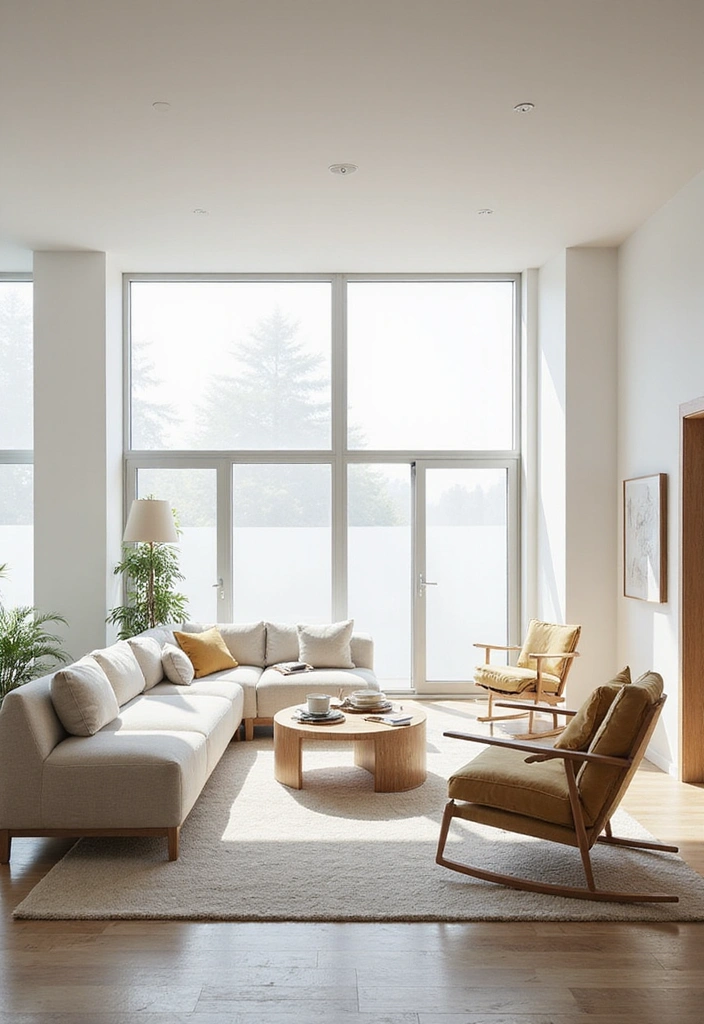
One of the hallmark features of Japanese living rooms is the emphasis on open spaces and natural light.
Large windows, often devoid of heavy curtains, allow sunlight to pour in, creating a warm and inviting atmosphere.
Consider using sheer fabrics for window treatments, which can soften the light while maintaining an airy feel.
This design choice not only enhances the aesthetic appeal but also promotes a connection with the outdoors, making the living room feel more expansive.
Try arranging furniture to complement the shape of the room and keep pathways clear to maintain that open vibe.
– Choose light-colored walls to reflect light.
– Incorporate plants for a touch of nature.
– Use low-profile furniture to create a sense of space.
Embracing natural light can truly transform your living area into a peaceful retreat.
2. The Art of Minimalism

Minimalism is not just a look; it’s a philosophy that encourages simplicity and purpose in every element of design.
In a Japanese living room, this translates to a careful selection of furniture and decor that serves a clear function.
Instead of clutter, focus on a few key pieces that resonate with you. A low wooden table can become a centerpiece, while floor cushions can provide seating without overwhelming the space.
Decorative elements should be sparse yet impactful – think elegant vases with a single flower or a framed piece of art that speaks to you.
– Embrace the “less is more” mantra.
– Switch out seasonal decorations to keep things fresh without cluttering.
– Consider multi-functional furniture to maximize space and reduce excess.
This minimalist approach to design can create a sense of calm and clarity in your home.
3. Textures that Tell a Story
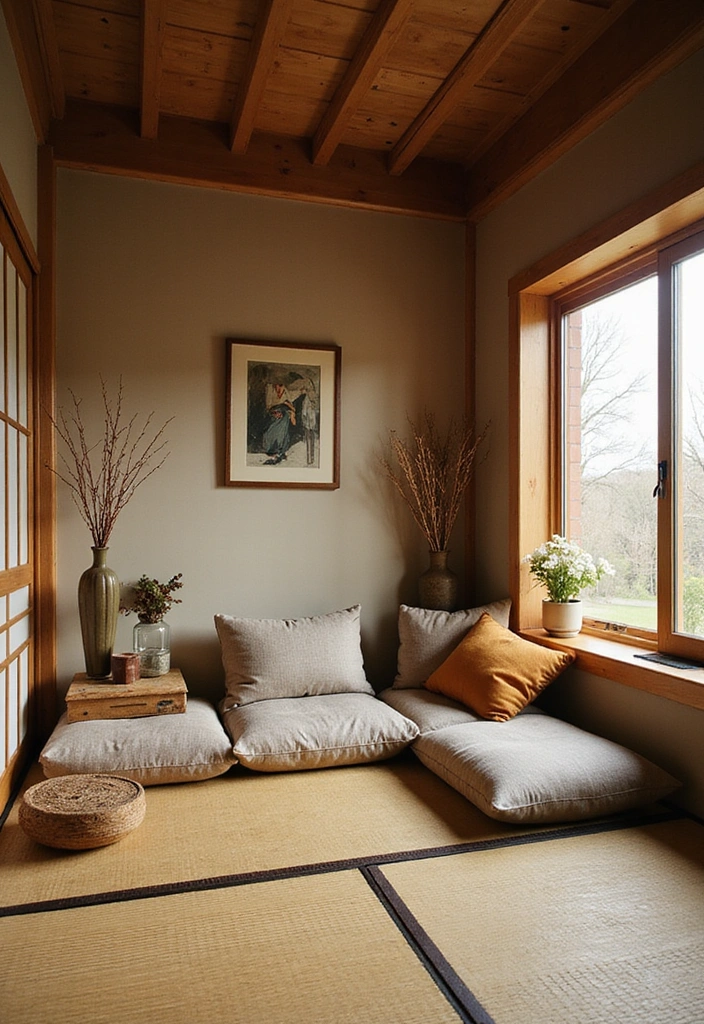
Textures play a significant role in Japanese decor, adding depth and interest without overwhelming the senses.
Incorporate materials like bamboo, wood, and stone to create a tactile experience.
A tatami mat underfoot offers warmth and comfort, while smooth wooden tables and textured cushions invite touch and relaxation.
Layering different textures can add a cozy feel without cluttering the space visually. For instance, complement a soft rug with woven baskets or textiles that bring an organic touch to the room.
Suggestions:
– Mix soft fabrics with natural elements for comfort.
– Use handmade items for that unique, personal touch.
– Highlight the beauty of imperfections, a key concept in Japanese aesthetics, through rustic finishes or asymmetrical designs.
This approach not only elevates the design but also creates a welcoming environment that feels alive.
4. Zen-Inspired Decor

The essence of Japanese design often finds its roots in Zen philosophy, which stresses simplicity and tranquility.
Infusing your living room with Zen-inspired decor can carve out a peaceful personal retreat.
Think of elements like a small rock garden or an inviting indoor water feature, which can bring a sense of calm and mindfulness to the space.
Artwork such as traditional Japanese scrolls can serve as focal points, while the strategic use of negative space encourages relaxation and contemplation.
for incorporating Zen elements:
– Opt for a muted color palette that promotes serenity.
– Integrate natural elements like stones and water features.
– Choose artwork that embodies nature, such as landscapes or flora.
Creating a Zen-inspired living room can be a beautiful way to invite peace into your life.
5. Sliding Shoji Screens
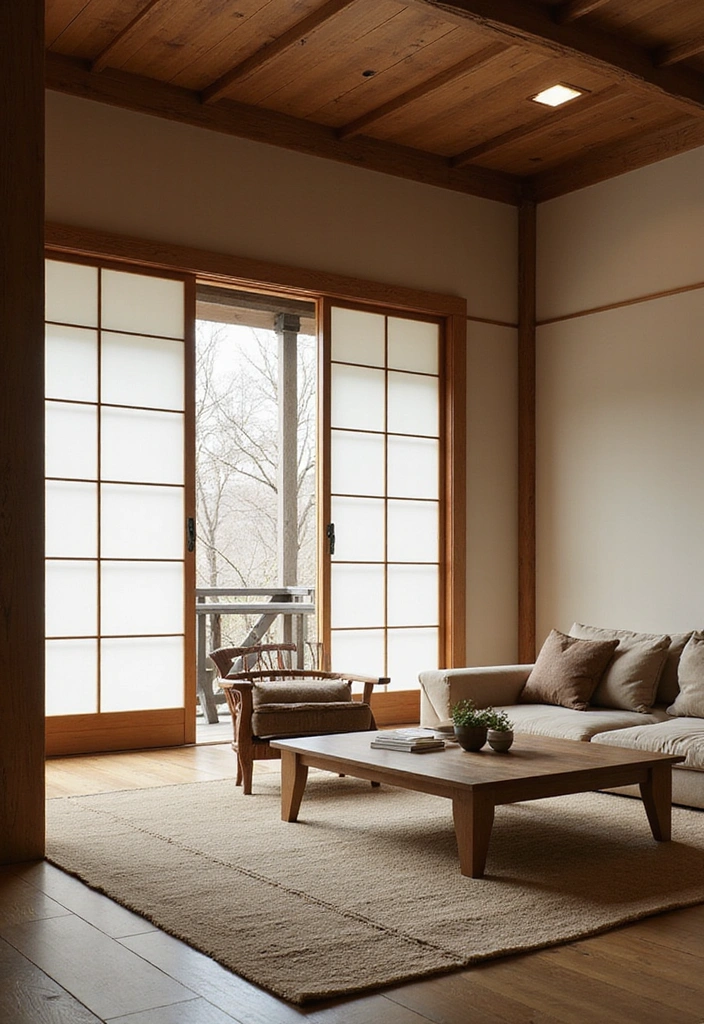
Shoji screens are a staple in Japanese homes, not just for their aesthetic appeal, but also for their practicality.
These sliding panels can act as a room divider or a way to let in light while providing privacy.
Made of thin wooden frames and translucent rice paper, they soften the harshness of light and create a serene ambiance.
Imagine a living room where the shoji screen can be easily moved to alter the space according to your needs.
Suggestions:
– Incorporate shoji screens as a stylish way to separate your living area from other spaces.
– Choose screens with unique patterns or textures for added interest.
– Use them as a backdrop for a serene reading nook.
With shoji screens, you gain the flexibility to transform your living room without compromising its minimalist essence.
6. Natural Color Palettes
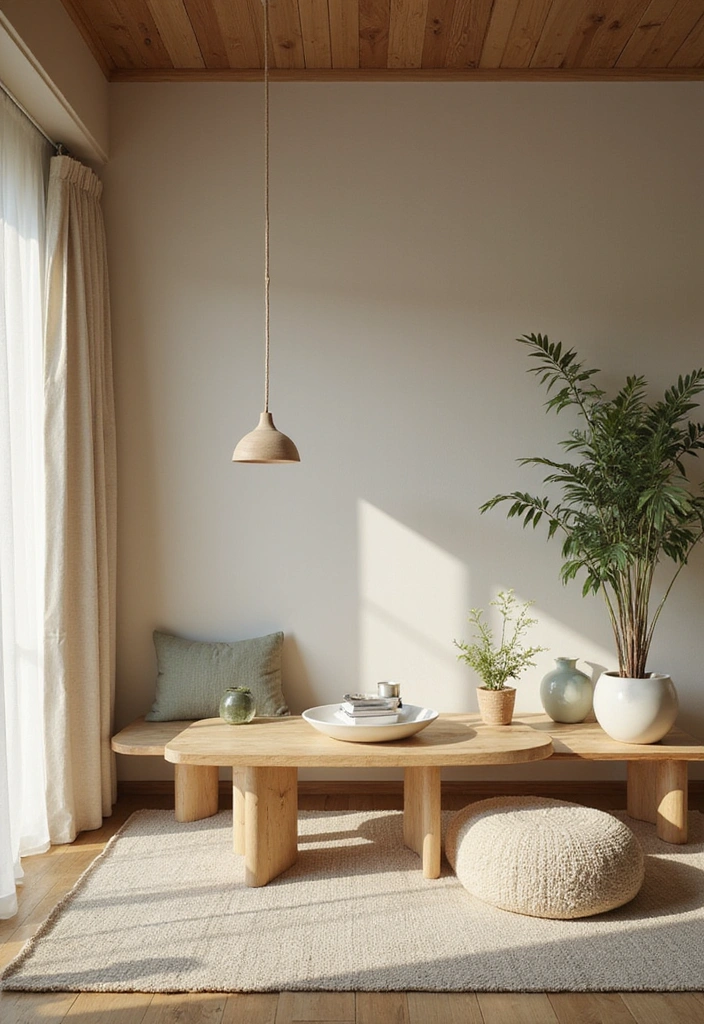
Drawing inspiration from nature, Japanese living rooms often utilize a natural color palette that feels calm and inviting.
Soft earth tones, muted greens, and deep browns can create a harmonious environment, perfect for relaxation.
Think about painting your walls in warm beige or soft pale green to evoke feelings of tranquility.
Accentuate these tones with furniture and decor in complementary colors that reflect the beauty of the outdoors.
– Use accent colors sparingly to maintain a sense of simplicity.
– Incorporate natural materials like wood in varying shades to keep the palette cohesive but interesting.
– Use indoor plants to add vibrant pops of green without overwhelming the color scheme.
This natural palette will not only transform your living room into a serene oasis but can also enhance your overall mood.
7. Multifunctional Furniture
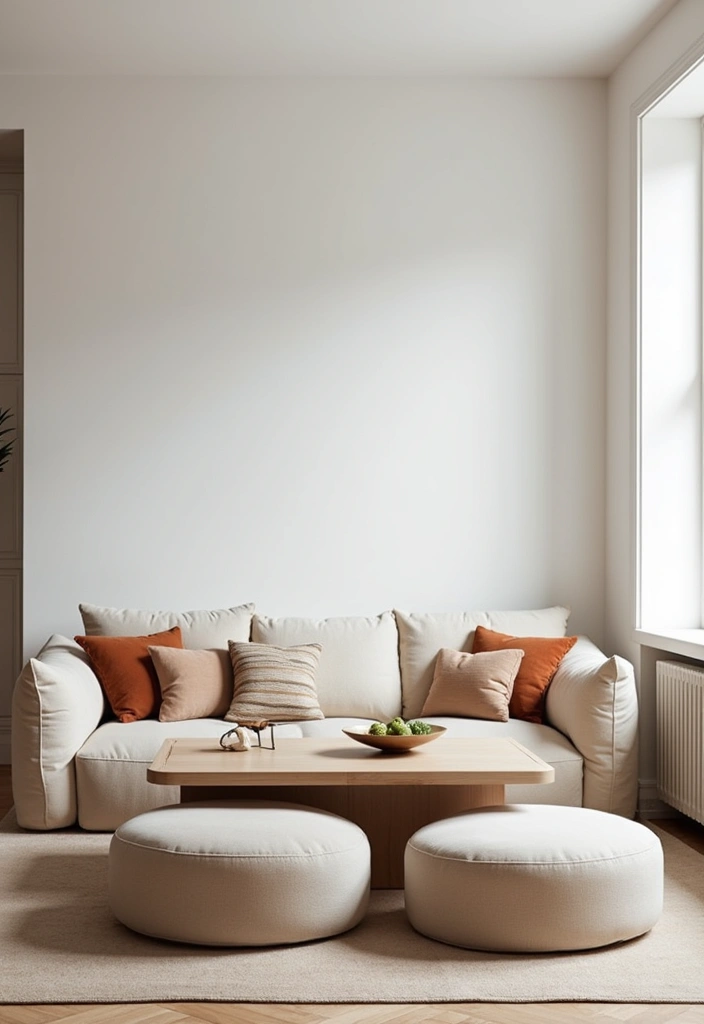
In many Japanese homes, space is at a premium, making multifunctional furniture essential.
A low coffee table that can double as a dining table is a perfect example of how to maximize utility without sacrificing style.
Consider adding an ottoman that can serve both as a seat and a storage solution for blankets or books.
This approach not only helps keep clutter to a minimum but also enhances the minimalist aesthetic.
– Look for furniture that can pivot between uses, like a folding table.
– Use benches with hidden storage compartments to increase functionality.
– Choose lightweight furniture that can be easily moved around.
Incorporating multifunctional pieces will help you maintain a spacious feel while ensuring that your living room meets your daily needs.
8. Incorporating Nature Indoors
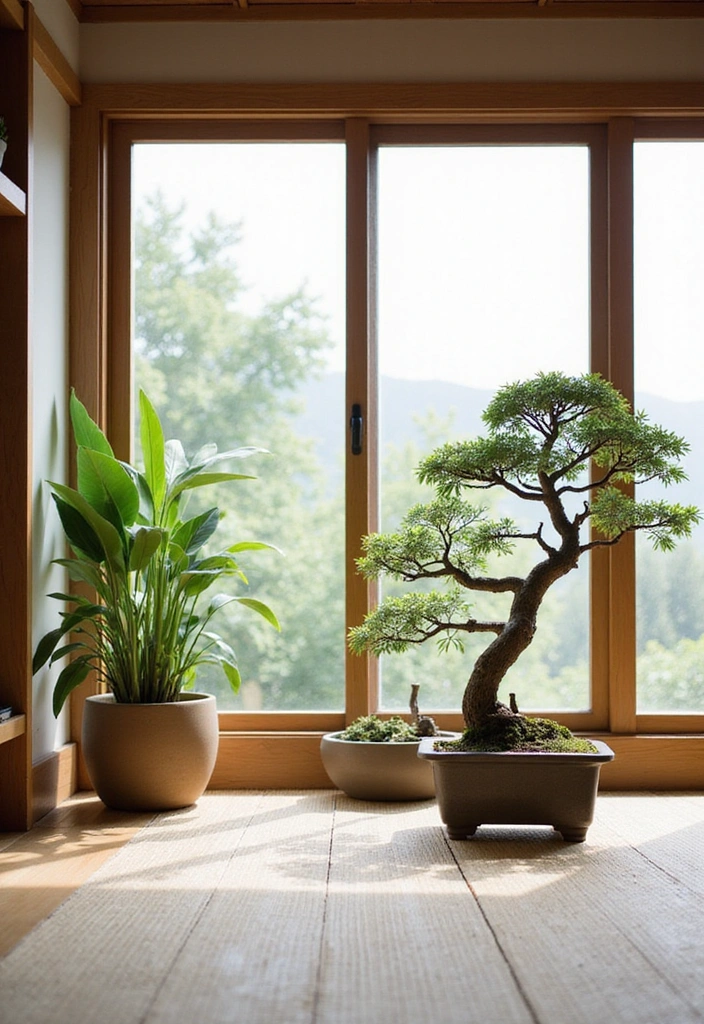
Bringing the outside in is a key principle of Japanese decor, celebrating the beauty of nature within your living space.
Consider adding potted plants, bonsai trees, or even small indoor water features that mimic the tranquility of the natural world.
A simple arrangement of rocks and plants can create a stunning focal point, while a single flower in a minimalist vase can add a touch of elegance.
– Choose low-maintenance plants that fit the minimalist aesthetic, like succulents or ferns.
– Arrange plants thoughtfully to create balance and harmony within the room.
– Use natural materials like stone and wood to complement your plant choices.
This approach fosters a sense of peace and connection with nature, vital in any Japanese-inspired living room.
9. Neutral Textiles
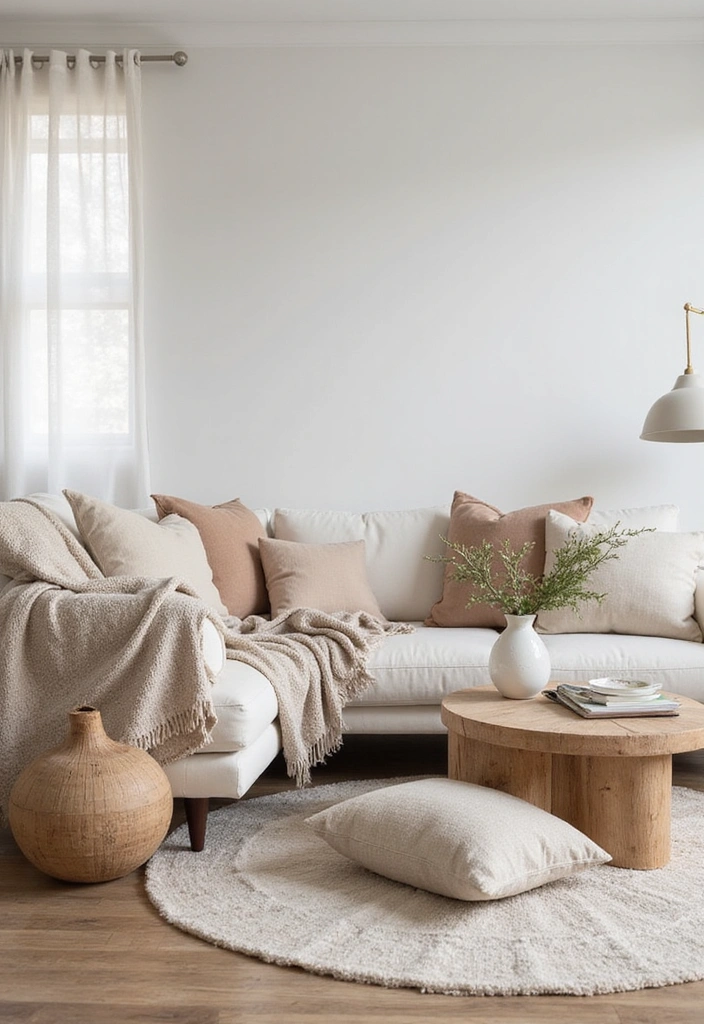
When it comes to textiles in a Japanese living room, less is often more.
Opt for neutral textures that complement your decor without drawing attention away from the overall aesthetic.
Natural fabrics like linen, cotton, and wool can offer both comfort and elegance in your seating and decor.
Consider using simple throws and cushions in earthy hues to soften the space without cluttering it visually.
Recommendations:
– Choose fabrics that are easy to clean and maintain.
– Layer different textures subtly to add interest while keeping the look cohesive.
– Stick to a simple color palette that aligns with your overall design theme.
The right textiles can enhance the minimalist feel of your living room, lending warmth and comfort without overwhelming the serenity of the space.
10. Art with Meaning

Art is a beautiful way to convey emotions and stories in any living space, particularly in Japanese decor.
Choose pieces that resonate with you personally or reflect your experiences. Simple landscape paintings, calligraphy, or traditional Japanese art can be stunning focal points.
The key is to keep it minimal – one or two pieces can make a bigger impact than a crowded gallery wall.
Suggestions:
– Position art at eye level to create a more personal connection.
– Frame artworks in natural wood to tie the pieces into the overall aesthetic.
– Consider rotating your art periodically to keep the space feeling fresh.
Art with meaning can breathe life into your minimalist living room, infusing it with personality and depth.
11. Traditional Elements

Infusing traditional Japanese elements into a modern living room can create a unique and compelling design.
Items like a tatami mat or decorative kimono fabrics can add a touch of authenticity while still maintaining a contemporary feel.
Incorporate vintage Japanese ceramics or lacquerware to enhance the cultural essence.
– Blend traditional pieces with modern furniture for a harmonious juxtaposition.
– Use colors and materials found in traditional design as inspiration for modern decor.
– Embrace asymmetry, often seen in traditional Japanese design, to add visual interest without chaos.
Incorporating these traditional elements can create a living room that feels both timeless and relevant.
12. A Focus on Craftsmanship

Japanese decor is renowned for its emphasis on craftsmanship and attention to detail.
Investing in quality pieces, whether handmade furniture or artisanal decor, can elevate your living room’s aesthetic and durability.
Look for items that showcase fine craftsmanship, like a beautifully constructed wooden chair or a handwoven rug.
Suggestions:
– Choose items that are not only functional but also tell a story of their creation.
– Support local artisans or craftsmen to find unique pieces that celebrate craftsmanship.
– Pay attention to the details, such as joinery or finish, as they can add to the overall beauty of the space.
Adding handcrafted items not only supports artisans but also enriches your living room with character and soul.
13. Calm Color Accents

In a minimalist Japanese living room, color accents should serve to enhance rather than distract.
Use calm hues like soft blues, muted greens, or warm earth tones that echo the colors found in nature.
Accents can be introduced through cushions, artwork, or a rug, creating harmonious pops of color that draw the eye without overwhelming the senses.
– Limit your color palette to two or three accent colors for cohesiveness.
– Choose soft patterns that evoke a sense of tranquility.
– Balance brighter accent colors with more subdued tones to maintain a peaceful atmosphere.
This careful control over color can elevate your living room, making it feel both vibrant and soothing.
14. Floor Seating

Floor seating is a traditional aspect of Japanese living that adds a unique touch to modern minimalist designs.
Simple cushions, floor mats, or low benches can invite relaxation while maximizing space.
This style encourages social interaction and a sense of togetherness, making it perfect for intimate gatherings.
Suggestions:
– Use lightweight, easy-to-move seating options to maintain flexibility in your space.
– Layer different textures with your floor seating to create comfort.
– Consider the arrangement to promote conversation and connection.
Incorporating floor seating can add a playful yet serene vibe to your minimalist living room, encouraging comfort and community.
15. Element of Water
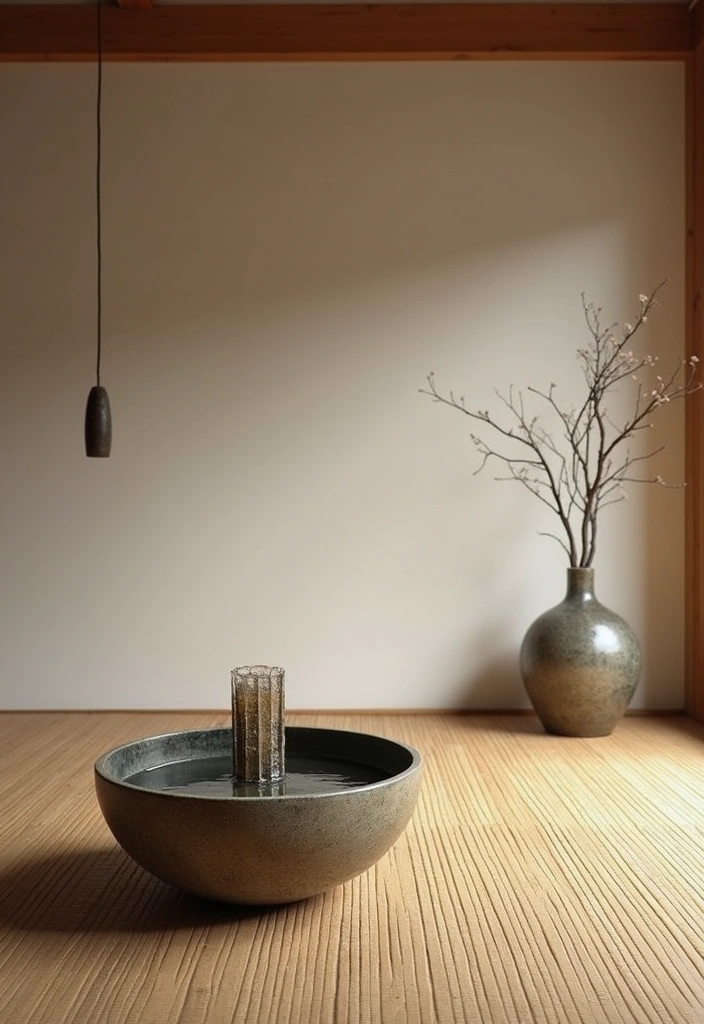
Water elements can introduce tranquility and balance into your living room, reflecting the calmness of Japanese design.
Consider incorporating a small indoor fountain or a decorative bowl of water with floating candles or flowers.
These elements create soothing sounds and visual aesthetics that draw the eyes and calm the mind.
– Use water features as focal points within your room for added serenity.
– Choose designs that are simple and unobtrusive, in keeping with the minimalist ethos.
– Ensure that the water elements are easy to maintain and clean.
Integrating water can enhance the peaceful atmosphere of your minimalist living room while perfectly aligning with Japanese design principles.
16. Seasonal Decor Switch-ups
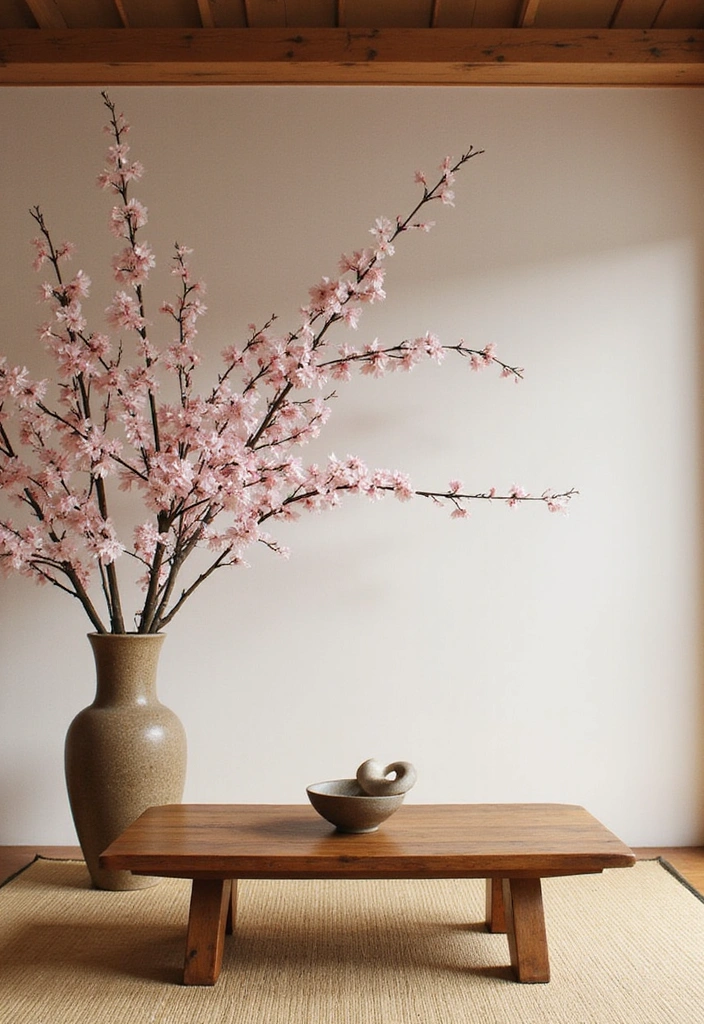
Embrace the beauty of each changing season by integrating seasonal decor into your minimalist Japanese living room.
This can be as simple as changing out cushions or adding fresh flowers that reflect the current time of year.
In spring, cherry blossom branches can create a stunning centerpiece, while autumn might call for warm-toned textiles.
– Keep a base decor that remains consistent while allowing seasonal touches to shine.
– Store off-season decor neatly to maintain a clutter-free environment.
– Choose items that can transition easily between seasons for sustainability.
This practice not only refreshes your space but also connects you to the cyclical nature of life in a beautiful way.
17. Embracing Asymmetry
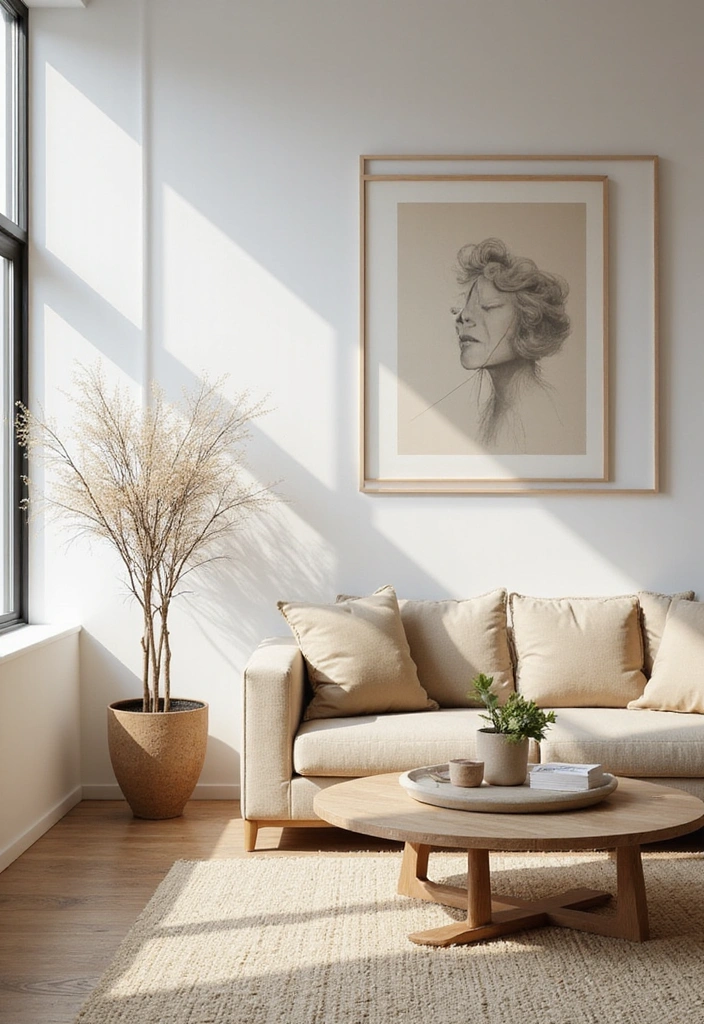
Asymmetry can be a powerful tool in Japanese-inspired design, adding balance while breaking away from traditional norms.
Instead of perfectly symmetrical arrangements, try placing decor and furniture in a way that feels naturally balanced.
For example, a large art piece could be complemented by smaller items on the opposite side of the room, creating a sense of flow without being forced.
Insights:
– Use asymmetry to create focal points that draw interest.
– Arrange furniture in a way that encourages movement and interaction.
– Let the eye wander, creating a relaxed atmosphere where the imperfect feels beautiful.
Embracing asymmetry can lend your living room a unique character, making it feel more dynamic and engaging.
18. Cozy Nooks
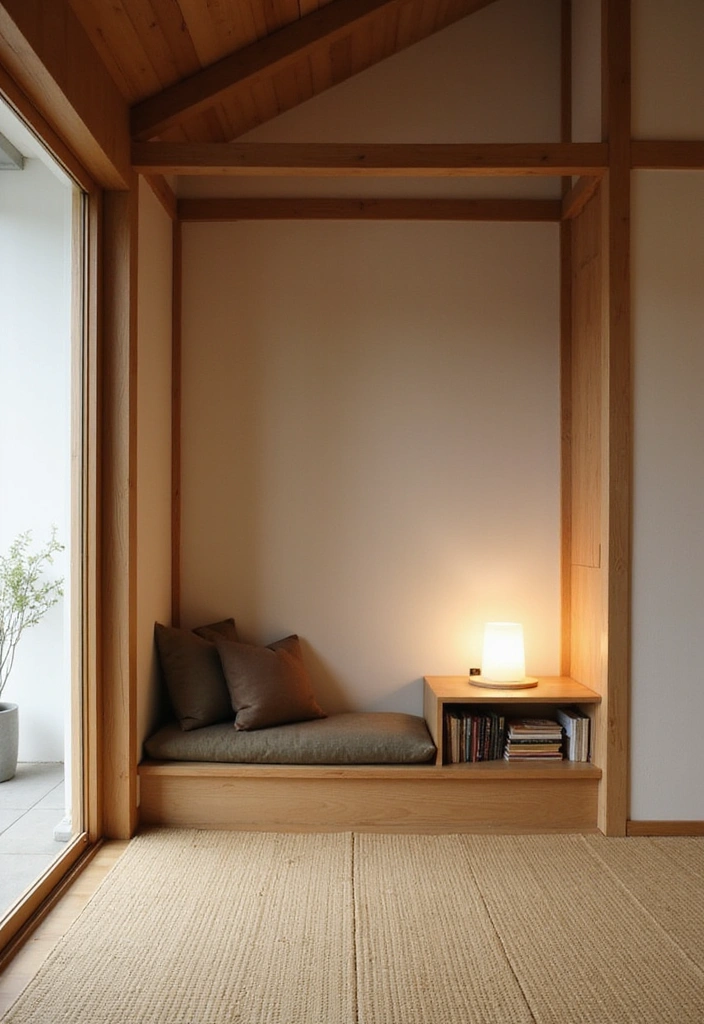
Creating cozy nooks within your living room can add layers of comfort and warmth to a minimalist design.
Consider carving out a small reading corner with a plush cushion and a low bookshelf, inviting relaxation.
Incorporate soft lighting, such as a small lamp or candle, to enhance the intimate atmosphere.
Recommendations:
– Use natural materials for seating, like a bamboo bench or a wooden stool.
– Arrange your cozy nook to face a window or a beautiful view, promoting tranquility.
– Keep it simple by limiting decor to just a few cherished items that invoke joy.
These nooks not only make your space feel inviting but also provide a personal retreat in your minimalist dwelling.
Conclusion
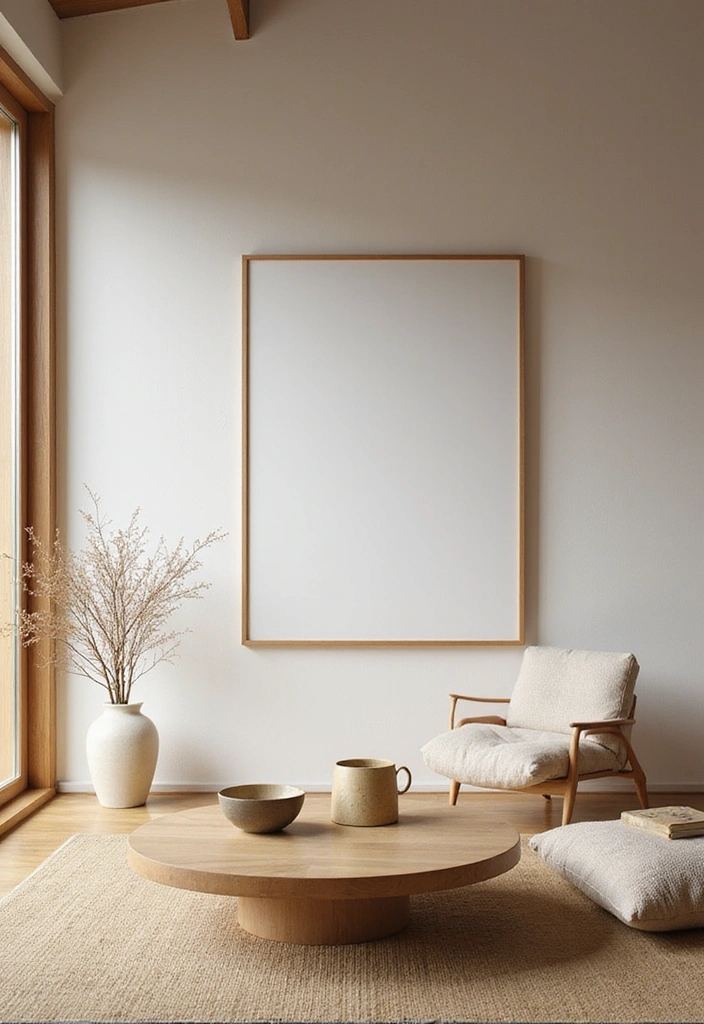
Transforming your living room with minimalist Japanese decor is not just about aesthetics; it’s about creating a harmonious space that reflects peace and simplicity.
With the right elements, from natural materials to thoughtful design choices, you can craft an environment that promotes relaxation and mindfulness in your daily life.
Explore these ideas and find the inspiration that resonates with you to create your own serene sanctuary.

